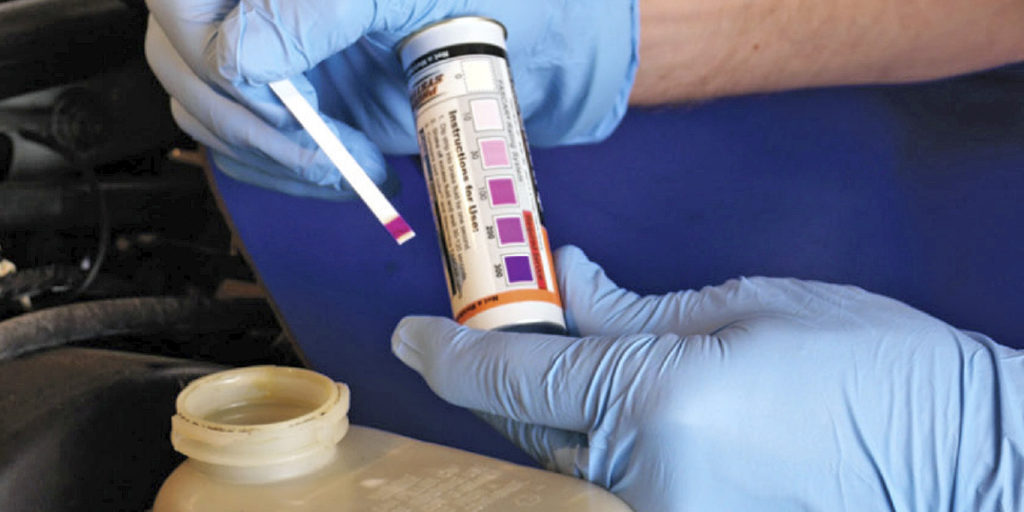Brake fluid is one of the most neglected fluids under the hood of a vehicle. Rarely will a customer ask for a shop to flush it and shops are reluctant to sell the service unless there is a problem or it is tied to a brake repair. But, fresh brake fluid can protect some of the most components on a vehicle.
TESTING
When does brake fluid go bad? It is a difficult question that differs depending on the automaker, type of brake fluid and brake system. For brake fluid replacement in the field, it is not about when but why.
Visual inspection of the fluid can be extremely misleading. The color of brake fluid can vary from clear to shades of blue. Even if the brake fluid is discolored or cloudy, it might still meet the system’s performance requirements. The brake fluid in the master cylinder reservoir can have a far different appearance than the fluid contained in the calipers. But, if you can see debris in the fluid with your naked eye, it could be a sign that rubber in seals or hoses are starting to degrade. Or, it could be the customer left the cap off the reservoir.
Brake fluid condition depends on two types of indicators, water concentration and the condition or the additive package. Water concentration is an easy measurement. But, measuring the condition of the additive package requires at looking at factors controlled by the additive package.
The worry about water concentration or moisture levels has been around for decades. Since brake fluid is hydroscopic, meaning it absorbs moisture in the air, the water changes the boiling point for the brake fluid. Testing for moisture can be done several ways. First, some testers can boil a small sample of brake fluid. Second, some testers are refractometers that measure the specific gravity of the brake fluid to determine the boiling point. Third, some newer testers pass electricity through the brake fluid to measure the resistance. Any tester is better than no tester at all.
Measuring the pH of the fluid can capture the condition of the additive packages in all brake fluid. These additive packages have buffers that control the pH. Additives that regulate the pH of the fluid have a limited lifespan and can absorb only so much acid before they are depleted. When the buffers are gone, the pH of the fluid can rapidly rise. Testing the pH of the brake fluid can be performed with a test strip, which can be used to justify brake fluid services to the customer.
Another method is to measure the amount of copper in the brake fluid. Copper is used to coat the insides of hydraulic brake lines. As the additive package in the brake fluid wears out and corrosion occurs, the copper is pulled off the insides of the brake lines and becomes suspended in the brake fluid. The more copper in the brake fluid, the more corrosive the brake fluid becomes. Testing of copper concentrations can be performed with test strips, and the results can be shared with the customer.
Brake fluid replacement is more critical than ever before. Since 2008, almost every vehicle has come with some form of ABS and a hydraulic control module mounted under the hood or on a frame rail. Since 2012, every light vehicle sold has been equipped with stability control that has added valves and complexity to the hydraulic control unit. The hydraulic control unit needs fresh brake fluid to operate and protect valves and passages from corrosion. An additive package helps control the pH, cavitation and viscosity.
BLEEDING AND FLUSHING
Replacing brake fluid requires more tools and skills than changing oil. Old-school methods like the two-man manual or gravity bleeding still work, but they are not efficient at replacing large volumes of brake fluid in a short period of time.
Machines that can power or pressure-bleed a system can make a fluid flush as efficient and profitable as possible and remove all of the air from the system. These machines are changing because of ABS and stability control systems. In the past, only 15-30 psi was required to pressure-bleed the system. Some new systems may require 50-60 psi to bleed or flush the system.
The other bleed or flush procedure that is often ignored is using a scan tool to actuate the hydraulic control unit. The worst fluid is trapped in the ABS valves and passages due to its non-integral design.
You should never feel bad about recommending brake fluid replacement if you have the right tools to test and flush the brake fluid. It is cheap insurance that will protect the vehicle’s hydraulic components.














